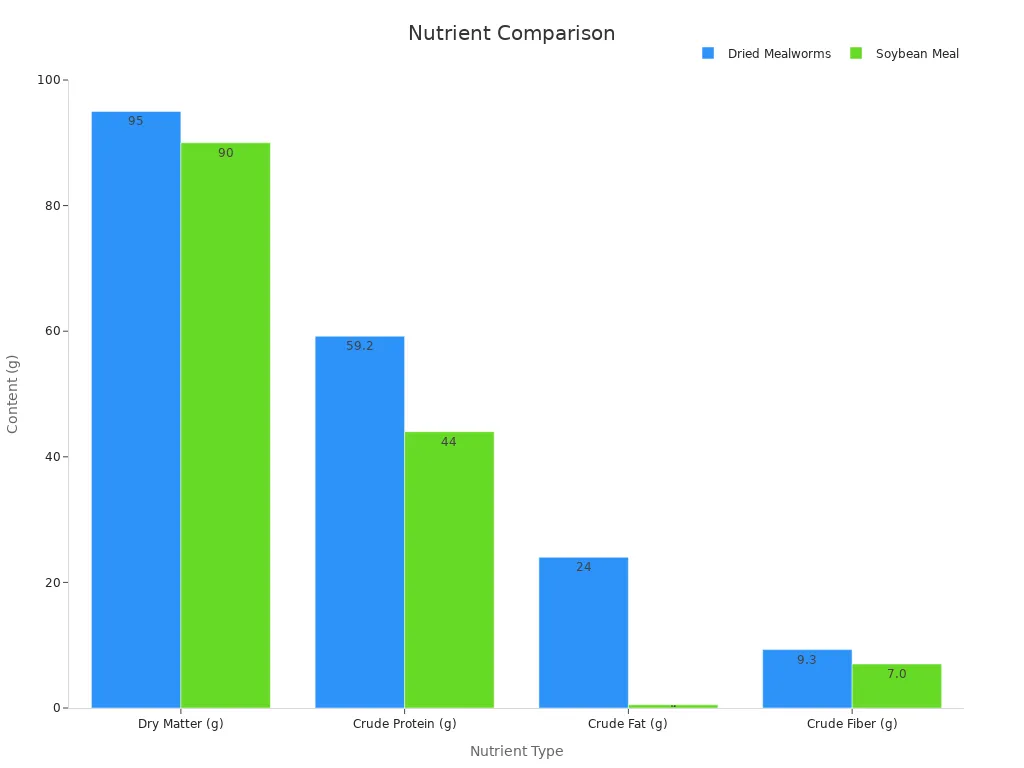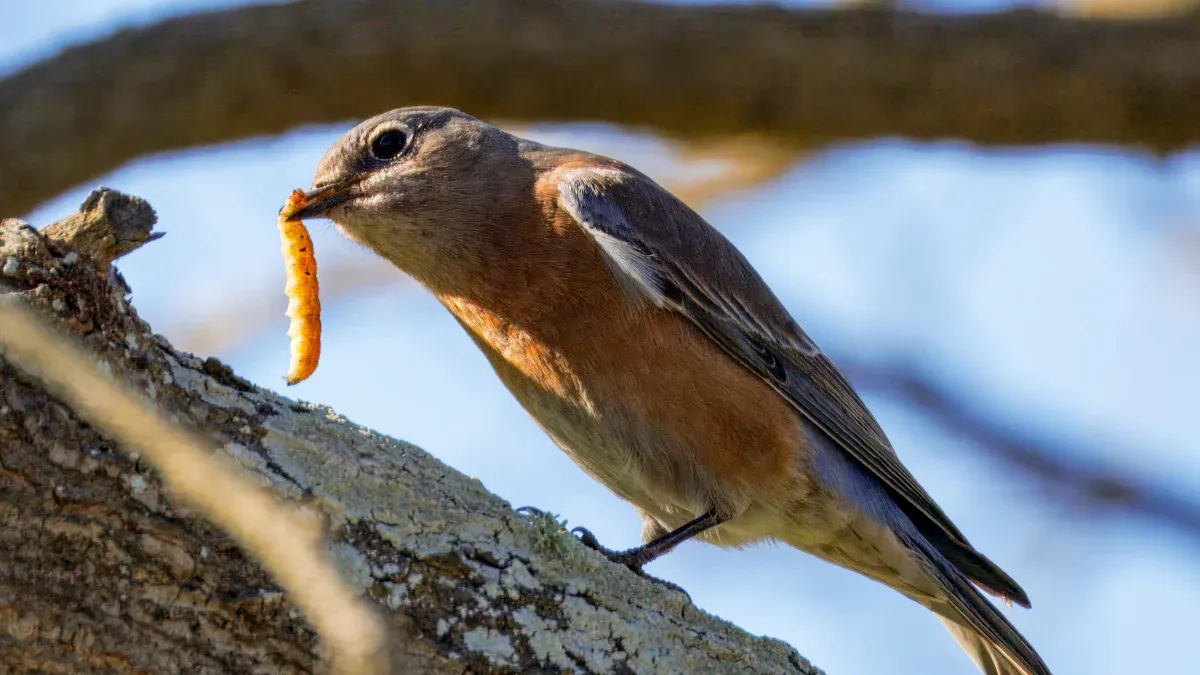
Bird lovers often search for ways to keep their feathered friends happy and healthy. Dried mealworms bird food offers an easy solution. Packed with protein, these treats give birds the energy they need to thrive. They attract a variety of species, from robins to bluebirds. Plus, their long shelf life makes them a practical choice for any bird feeding routine.
Key Takeaways
- Dried mealworms are healthy snacks for birds. They are full of protein, fat, and fiber. These help birds during breeding and migration. Adding them to bird food is a great idea.
- Use open tray or platform feeders to attract more birds. Place feeders in calm spots near bushes for safety and easy access.
- Mix dried mealworms with seeds or fruits for variety. This makes a balanced diet and attracts more bird types.
Benefits of Dried Mealworms Bird Food
Packed with Essential Nutrients
Dried mealworms are a powerhouse of nutrition for birds. They offer a balanced mix of protein, fat, and fiber, which supports birds during critical times like breeding and migration. For example, egg-laying females and growing chicks benefit from the calcium found in mealworms. Compared to other bird foods, dried mealworms stand out for their high protein content, which is essential for muscle development and energy.
| Nutrient Type | Dried Mealworms | Soybean Meal |
|---|---|---|
| Dry Matter (g) | 95 | 90 |
| Crude Protein (g) | 59.2 | 44 |
| Crude Fat (g) | 24 | 0.5 |
| Crude Fiber (g) | 9.3 | 7.0 |
This table highlights how dried mealworms bird food surpasses soybean meal in key nutrients, making it a superior choice for backyard birds.

Appeals to a Wide Range of Bird Species
One of the best things about dried mealworms is their universal appeal. Many insect-eating birds, such as bluebirds, robins, and warblers, find them irresistible. These birds rely on protein-rich foods, especially during the summer when they are raising their young.
- Birds that enjoy dried mealworms include:
- Wrens
- Grosbeaks
- Mockingbirds
- Brown Thrashers
By adding dried mealworms bird food to your feeders, you can attract a diverse group of feathered visitors to your backyard.
Convenient and Cost-Effective
Dried mealworms are not only nutritious but also incredibly convenient. They have a long shelf life and can be stored at room temperature without refrigeration. Unlike live mealworms, they don’t create dust or waste, making them easy to handle and feed.
- Key benefits of dried mealworms:
- Long shelf life
- No special storage required
- Easy to feed without mess
These features make dried mealworms bird food a practical and cost-effective option for bird enthusiasts. You can stock up without worrying about spoilage, ensuring your feathered friends always have access to a nutritious treat.
Feeding Birds with Dried Mealworms
Choosing the Right Feeders
Selecting the right feeder is essential when offering dried mealworms to birds. Open tray feeders work best because they allow birds to easily spot and access the mealworms. Platform feeders are another great option, especially for ground-feeding birds like robins and thrushes. For smaller birds, such as chickadees or wrens, a hanging feeder with a shallow dish can be ideal.
To prevent waste, use feeders with raised edges to keep the mealworms from spilling out. Placing the feeder in a shaded area can also help preserve the quality of the mealworms, especially during hot weather. If squirrels or other animals frequent your yard, consider using a feeder with a built-in guard to protect the food.
Tip: Start by placing a small amount of dried mealworms in the feeder. Birds may take time to recognize this new food source, but once they do, they’ll keep coming back for more.
Mixing Mealworms with Other Bird Foods
Dried mealworms bird food can be even more effective when mixed with other types of bird feed. Combining mealworms with seeds, suet, or fruits creates a balanced diet that appeals to a wider variety of birds. For example, mixing mealworms with sunflower seeds can attract both insect-eating and seed-eating species.
Layering mealworms on top of other foods in the feeder can encourage birds to try them. This method works well for birds unfamiliar with mealworms. Additionally, sprinkling mealworms on the ground near feeders can attract ground-feeding birds like sparrows and juncos.
Studies show that adding dried mealworms to a bird’s diet improves their overall nutrition. The high protein content and essential amino acids in mealworms support better gut health, which leads to increased activity levels in birds. This makes them an excellent addition to any bird feeding routine.
Seasonal Feeding Tips
Birds’ dietary needs change with the seasons, and dried mealworms can play a key role in meeting those needs. During spring and summer, birds require extra protein for breeding and raising their young. Offering mealworms during these months can help support egg-laying females and growing chicks. However, it’s important to note that dried mealworms lack moisture, which is critical for newly hatched nestlings. To address this, provide a water source nearby or soak the mealworms in water before feeding them.
In fall and winter, birds need high-energy foods to stay warm. Mixing mealworms with suet or nuts can provide the extra calories they need. Placing feeders in sheltered areas can also help birds conserve energy while feeding.
Note: Keep an eye on the weather. During rainy or humid conditions, store mealworms properly to prevent them from becoming soggy or attracting pests.
Proper Storage for Dried Mealworms Bird Food
Best Practices for Storage
Proper storage ensures that dried mealworms bird food stays fresh and nutritious for your feathered visitors. A cool, dry place works best for maintaining their quality. Temperatures between 50°F and 60°F help prevent spoilage while keeping the mealworms crunchy. Airtight containers, like glass jars or sturdy plastic bins, are ideal for keeping moisture and pests out. Adding a paper towel inside the container can absorb any excess moisture, further protecting the mealworms.
For long-term storage, freezing is a great option. Mealworms stored at temperatures below -15°C can stay fresh for over six months. Always keep the storage area clean and away from strong odors to avoid contamination.
Preventing Moisture and Pests
Moisture and pests are the biggest threats to dried mealworms. To prevent these issues, use airtight containers with secure lids. This keeps pests like ants or moths from sneaking in. Placing the container in a dry spot, away from humidity, also helps. If you live in a humid climate, consider using silica gel packets or a dehumidifier near the storage area.
Regularly check the mealworms for signs of pests or foul odors. If you notice anything unusual, discard the affected batch immediately. Keeping the storage area clean and free of crumbs or spills can also deter unwanted visitors.
Understanding Shelf Life and Expiration
Dried mealworms have an impressive shelf life when stored correctly. At room temperature, they can last several months. However, freezing them can extend their freshness for up to a year. Always check the packaging for expiration dates and use older batches first.
If the mealworms develop a stale smell or lose their crunch, it’s time to replace them. Proper storage not only preserves their nutritional value but also ensures they remain an appealing treat for birds.
Attracting Birds to Dried Mealworms

Strategic Placement of Feeders
Where you place feeders can make a big difference in attracting birds to dried mealworms. Birds feel safer when feeders are near shrubs or trees, as these provide quick escape routes from predators. Positioning feeders in quiet areas of the yard also helps, as birds prefer spots with minimal human activity.
Using feeders with tall sides, roofs, and drainage holes keeps mealworms secure and fresh. These features protect the food from rain and curious animals. For ground-feeding birds like robins, placing a tray feeder on the ground works well. Hanging feeders with shallow dishes attract smaller birds, such as chickadees and wrens.
Patience and Observation
Attracting birds takes time. Birds may not recognize dried mealworms as food right away. Start by offering small amounts and observe their behavior. Some birds might approach cautiously, while others may ignore the feeder at first.
Keep an eye on the types of birds visiting your yard. Adjust the feeder placement or quantity of mealworms based on their preferences. Over time, birds will associate your yard with a reliable food source and return regularly.
Tip: Moisten dried mealworms to make them more appealing. Birds often prefer softer textures, especially during spring when feeding their young.
Using Mealworms with Other Attractants
Combining dried mealworms with other attractants can draw more birds. Pairing mealworms with fruits, seeds, or suet creates a diverse menu that appeals to different species. For example, placing mealworms alongside orange slices can attract orioles.
Sprinkling mealworms near feeders or on the ground can also entice ground-feeding birds. During spring, offering small quantities of mealworms ensures they stay fresh while providing birds with the protein they need for raising chicks.
Dried mealworms bird food offers a simple way to support birds with essential nutrients. They attract diverse species and provide reliable nutrition when natural food is scarce. Adding them to feeders creates a rewarding experience for bird lovers. Watching birds thrive with this nutritious snack brings joy and strengthens the bond with nature.


